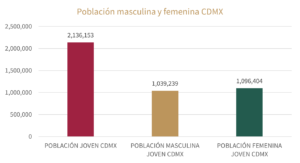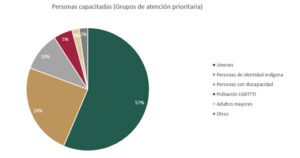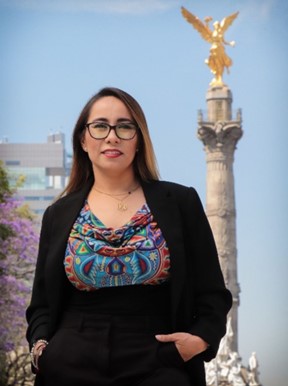By Ms. Alejandra Flores Bautista
Director General of the Training Institute
for Labor of Mexico City (ICAT)
Characteristics of the young population in Mexico City
The young population is that which is between 12 and 29 years of age, in terms of economic censuses it is established that young people are those between 15 and 29 years old, this population represents just over a quarter (26.5%) of the working age population in Mexico City[1]. Unlike what happens with adults, youth employment and unemployment have particular characteristics that generally place this group in conditions of disadvantage and labor vulnerability.
The transition from the classroom to the labour market for young people represents challenges and decision-making. In this transitional stage, the main problems that young people face in the labour market are unemployment, informality and low wages. Complete cycles of secondary and higher education mitigate, however, they do not eliminate these problems.
Normally, academic certificates have played a fundamental role in accessing formal employment, but not having them can sometimes be a barrier to accessing a large part of quality jobs. The dynamic market and the large availability of job offers, among other factors, have generated an increase in the qualification requirements to fill job vacancies. Unlike in the past, it is no longer only necessary to have educational certificates and years of work experience; candidates are also required to have other capacities and qualities, which are called demonstrable work competencies in the workplace.
One of the characteristic features of the young population in Mexico, particularly in Mexico City, is that the probability that a young person can start and sustain a small business increases with age and requires some degree of work experience.
During the first quarter of 2024, the country's total population was 129 million 713 thousand 690 people. Of this total, Mexico City represents 71% (9 million 328 thousand 730) of the population. Regarding the young population, the country has 30 million 889 thousand 351 (941% 3T3T) of young people, of which only 2 million 136 thousand 153 (61% 3T3T) of this population are in Mexico City.

Efforts made to serve the young working-age population in Mexico City.
The unemployed population is “people aged 15 and over who in the reference week sought work because they were not linked to an economic activity or work.” (INEGI)
The unemployed population in the first quarter of 2024 was 1 million 545 thousand 204 people in the country, likewise, at the national level there are 810 thousand 416 young people in an unemployed modality. On the other hand, the total unemployed population of Mexico City in the same period was 194 thousand 968 people (68%) and as for the young unemployed population in Mexico City, there are 93 thousand 397 people (32%) [2].
In this regard, the Government of Mexico City, through the Secretariat of Labor and Employment Promotion, has channeled significant efforts to address the employment needs of young people.
Firstly, we can mention the social programs: Promotion of Decent Work, with its respective subprograms called: temporary employment, green employment, get a job and training for well-being; additionally, the Social Unemployment Insurance Program and its respective Active Unemployment Insurance subprogram.
Primarily, these are monetary transfers for people who are unemployed or underemployed in Mexico City. Additionally, training and advice are offered for finding job opportunities, as well as for undertaking independent productive projects.
In the case of the subprogram: Active Unemployment Insurance, the aim is to generate an opportunity for community activity with its respective remuneration, while generating options for formal employment links, through applications on the National Employment System platform.
A very important characteristic of the Unemployment Insurance Program is that it is supported as a constitutional right and consists of offering an economic incentive of $3,300.53 (Three thousand three hundred pesos 53/100 MN) in addition to promoting the reintegration of people into the labor market through training and job exchange[3].
On the other hand, a large area of opportunity has been detected in terms of job training for the working population in Mexico City, particularly with the young population. Faced with this situation, the Mexico City Institute for Job Training (ICAT CDMX) has implemented work focused on generating an accessible training offer. In this order of ideas, the mission of ICAT CDMX is to "Guarantee people living in Mexico City access to training services and certification of job skills, through innovative and pertinent alternatives, which favor their connection with the productive apparatus and allow them to effectively exercise their right to decent work."
To this end, accessibility alternatives have been created by making courses available in face-to-face, online, live and mixed modalities. This offer is intended to enable more people, especially young people, to access quality training and eventually be able to certify their work skills so that this translates into improving their working conditions.
So far this year, ICAT CDMX has generated a wide range of courses and certification processes, which have mostly benefited young people. Of the total number of people trained, 15,034 are women (66.7%) and 7,520 are men (33.3%). Among the people trained, 57.5% belong to priority attention groups, young people together with people with indigenous identity represent the largest group[4].

It is necessary to implement new strategies to address the employability needs of youth in Mexico City. In this context of change in local administration, it is necessary not to lose sight of the achievements obtained, in addition to directing institutional efforts to benefit young people who daily face the challenges of a highly competitive economic system.
In general, it is important to maintain the vision of a public policy on labor matters, considering a rights-based approach and generating alternatives for everyone, placing emphasis on priority attention groups, of which youth are a part.
[1] https://www.inegi.org.mx/contenidos/saladeprensa/boletines/2023/enoen/enoen2023_03_b.pdf
[2] https://www.inegi.org.mx/app/indicadores/
[3] https://trabajo.cdmx.gob.mx/programa_sociales_y_servicios/seguro-de-desempleo
[4] Data obtained from the Progress Report of the Annual Work Plan PAT ICAT-CDMX 2024






